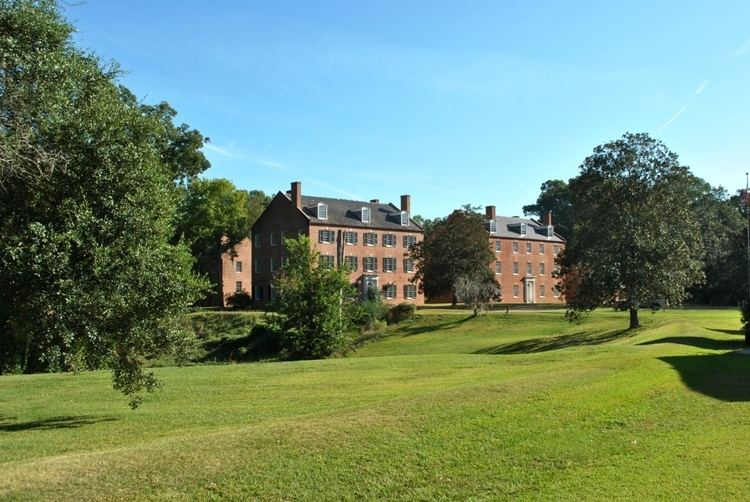Area 78.5 acres (31.8 ha) NRHP Reference # 70000316 Designated USMS May 9, 1985 Phone +1 601-442-2901 Added to NRHP 25 August 1970 | Built 1802 USMS # 001-WSH-0100-NR-ML Founded 1802 | |
 | ||
Address 16 Old N St, Natchez, MS 39120, USA Notable alumni Jefferson Davis, Albert G Brown, Paul Octave Hébert, Pete Heine, William Mackenzie Davidson Similar Elizabeth Female Academy, Oakland College, Jefferson Davis Communi, Transylvania University, Southwest Mississippi Communi Profiles | ||
Jefferson College, in Washington, Mississippi, was founded as an all-male college but operated primarily as a college preparatory school and later military boarding school during most of its history. Named in honor of Thomas Jefferson, the college was chartered in 1802, but did not begin operation until 1811.
Contents
- Development
- Military emphasis
- Decline
- Historic buildings
- Historic events at Jefferson College
- Notable alumni
- Jefferson College historic site
- In popular culture
- References
Due to declining enrollment and financial difficulties, the facility closed in 1964. The historic campus was listed on the National Register of Historic Places in 1970, and was designated a Mississippi Landmark in 1985. The site is operated as an historic museum and park.
Development
Chartered on May 13, 1802, by the General Assembly of the Mississippi Territory, Jefferson College was the first institution of higher learning in Mississippi. It opened in 1811 with 15 students, as a preparatory school, under the name Washington Academy—a one-room, wood-frame structure, built on the college property. By 1817, the institution had become a fully developed college. The first permanent buildings, constructed of brick, were completed in 1820. By 1840, Jefferson College offered the degrees of Bachelor of Arts and Master of Arts.
Military emphasis
During the American Civil War, Jefferson College was closed. After the end of the war, the buildings were used by the Freedmen's Bureau to aid transition to a society of free labor. In November 1865, the school's Board of Trustees regained control of the facility. The institution reopened in 1866 as a preparatory school and continued as such until it closed in 1964.
Between 1872 and 1911, under the tenure of Superintendent J.S. Raymond, the college had its longest interval of stable governance, with increased enrollment. By 1893, the institution had been reorganized as a military school, taking the name Jefferson Military College. Instruction was entirely secondary education. Early in the 20th century, dormitories were built to accommodate more recruits. By the late 1930s, enrollment had increased to about 100 students.
Decline
Following World War II, declining student enrollment, low tuition, and lack of external funding caused financial hardship for Jefferson College. After 150 years of operation and unable to pay its debts, the facility closed in May 1964. In 1965, all buildings and lands owned by Jefferson College were conveyed to the State of Mississippi in exchange for discharging the school's debts.
In 1971, Jefferson College was placed under administrative control of the Mississippi Department of Archives and History (MDAH). Detailed plans were developed for preserving the historic buildings, and restoration work began in the mid-1970s. In 1977, Jefferson College was opened to the public as a State Historic Site.
Historic buildings
Three buildings, constructed during the 19th century, are contributing resources for the Jefferson College National Historic District:
Jefferson College campus includes five other historic buildings constructed during the 19th and 20th centuries:
Historic events at Jefferson College
In January 1807, acting Governor Cowles Mead of the Mississippi Territory suspected Aaron Burr of a conspiracy to separate regions of Mississippi and Louisiana from the United States and ordered the territorial militia to capture Burr to stand trial for treason. In February 1807, a grand jury convened on the grounds of Jefferson College and found Burr not guilty of any crime or misdemeanor against the United States.
Between 1802 and 1817, Washington, Mississippi, was the capital of the Mississippi Territory, and the General Assembly of the territory often met in a tavern, known as Assembly Hall, which was located adjacent to Jefferson College. Assembly Hall was destroyed by fire in 1993.
Between July 7 and August 17, 1817, the Mississippi Statehood Convention was held in a Methodist church on property adjacent to Jefferson College. Over time, the church building deteriorated and was no longer standing by the mid-1870s.
Notable alumni
Jefferson College historic site
As a historic site, several buildings are open to the public. These include the West Wing, the kitchen buildings, and Prospere Hall. The T.J. Foster Nature Trails wind though an old-growth hardwood forest over distances of 0.5 miles (0.80 km) to 0.9 miles (1.4 km).
In popular culture
Jefferson College was a location site for the films:
